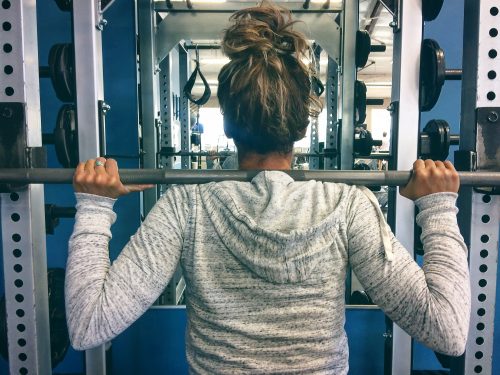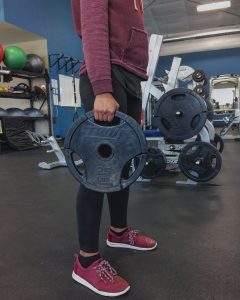
Female clients can use weight lifting to their advantage when wanting to lose weight. I generally don’t encourage a client’s main fitness goal to be “weight loss” because it can foster an unhealthy relationship with their self-image, body confidence and the health industry as a whole.
I am here to help my clients achieve their goals in the healthiest and most effective way possible not choose their goals for them. This requires a commitment to the gym and my services at some level – results being a key component to that commitment.
Lift Don’t Run!
I often see female gym members and clients going straight for the cardio machines and spending a tedious 40-60 minutes there, and that’s it! It’s as if the weights don’t even exist. These women have been in the understanding that the best way to lose weight is cardio, cardio and more cardio.
It makes sense, more calories are burned during a 60-minute cardio session than a counterpart lifting routine, it feels that one is working harder overall, and there is more actual work time during a run than in a lift session.

However, professionals of the health and fitness industry are starting to understand that a more effective mode for weight loss is heavy weight lifting. Especially if limited time is a factor!
Fat Oxidization for Weight Loss
The total calories used during a cardio session and a lifting session don’t compete. Especially if one is able to keep their mile time under 9 minutes. Depending on a client’s weight and mile time, they could be looking at burning anywhere from 300-600 calories per hour of endurance exercise, compared to an estimation of 200-350 calories in an hour of vigorous lifting.
Yet, something interesting happens to the body after a weight workout. It has been shown that post strength training, the body will use a greater percentage of fat calories for energy than compared to post endurance training. According to the Journal of Applied Physiology in 2003, researchers found fat oxidation post serious weightlifting was up 22% more than that of aerobic workouts.
This meaning that fat is continued to be used as a fuel source hours after the strength training. So even though more calories were used at the time of the aerobic exercise, there is an overall higher calorie deficit from the weightlifting.
Inefficiency is Key for Weight Loss
The human body is an incredible adapter, always finding ways to make physical work more efficient. Thus less energy expended. The body does this because it is ultimately best for “survival”. Using as few of its precious energy stores as possible, so it can always be ready to fight or flight in dangerous situations. This is left over from our prehistoric days, which is a mechanism that isn’t useful in modern day life when a client is trying to be energetically inefficient, hence lose weight.

If a client’s main mode of exercise is steady pace endurance exercise, the body will soon make this a more efficient activity and use less energy to do the same work. For individuals who participate in marathons, this adaption is exactly what they are looking for. Longer distances achieved with less fuel.
One of the ways the body does this is by shrinking some of its type 1 muscles fibers, less mass, less energy to provide. For clients wanting to lose weight, aka burn more fuel, this mode of exercise is not very effective.
To maintain weight loss with aerobics, a client would always be needing to do more and more. Considering most clients don’t have that much time, or want to dedicate that time to their fitness routine, it’s another point for strength training.
It is not as easy for the body to adapt to the many different stresses and challenges of weightlifting, especially since a competent trainer is always progressing the client with greater weight, different exercise variations, compound movements and alternating the styles of lifting.
High-intensity lifting triggers the sympathetic nervous system, it puts the body into its fight or flight mode. Lifting challenges the nervous system, muscle cells and hormones. These responses are what allow a client to work hard in a strength training session and is also a contributor to how the body recovers after.
After a hard lifting session, the body continues to use more energy (calories) to recover and mend the “damage” of exercise, compared to what steady pace aerobics does.
Lastly, it is important to note that if a client is busy and on limited time, a 20-30 minute high-intensity anaerobic workout will be so much more beneficial to weight loss compared to a 20-30 minute aerobic workout. For all the reasons listed above.
And just to throw this in, remind your female clients who are worried about “bulking up”, that building really big muscles is hard! Doing 2-3 challenging strength training sessions a week will not give them a body builder physique. It will however,
– improve bone density
– increase lean body mass which improves insulin sensitivity
– lower risk of type 2 diabetes
– improve overall body composition which will in turn change the look of their body and their jeans will probably fit better.
Not to mention most woman report feeling like a rock star when they can start lifting heavier and heavier.
Weight lifting has an unfortunately long history of “being for the boys”, and I really believe that mentality needs to change. Other than what I have mentioned here, there are a slew of amazing benefits from a regular lifting regimen. This blog is just to help you convince some of your weight loss clients to hop off the treadmill and start doing some dead lifts!
So get your clients in the gym this holiday season and help them stay there, giving you all a head start on the New Year’s fitness resolutions!
If you’re looking for a little more on this subject, check out Cathleen Kronemer’s blog! https://nfpt.com/blog/women-weightlifting-good-bad-truth
Sources
Schuler, L., Forsythe, C. E., & Cosgrove, A. (2010). The new rules of lifting for women: Lift like a man, look like a goddess. London: Michael Joseph.
Maximize Fat Loss with Resistance Training. (n.d.). Retrieved from www.ptonthenet.com/articles/maximize-fat-loss-with-resistance-training-3578
Oaklander, Mandy. (2017, April). The Power of Strength Training. Time, The Science of Exercise (Special Edition). pp. 40-45.






